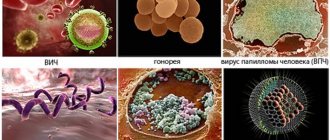- Magazine archive /
- 2019 /
Assessment of urethral scraping microbiota in men with sexually transmitted infections
DOI: https://dx.doi.org/10.18565/urology.2019.6.31-37
M.R. Rakhmatulina, M.N. Boldyreva, E.V. Lipova, A.S. Chekmarev, I.S. Galkina
1) Federal state budgetary institution “State Scientific Center of the Russian Federation - Federal Medical Biophysical Center named after. A. I. Burnazyan” FMBA of Russia, Moscow, Russia; 2), Moscow, Russia
Purpose of the study: to conduct a comparative study of the composition of the urethral microbiota of men with sexually transmitted infections (STIs) and healthy men. Materials and methods. The study included 103 men aged 18 to 45 years: 42 men with urethritis caused by STIs and 61 clinically healthy men. Identification of pathogenic and conditionally pathogenic microorganisms in scrapings from the urethra was carried out by real-time PCR using the Androflor® test system (DNA-Technology, Moscow). Results. When analyzing the indicators of the total bacterial mass, it was found that the bacterial contamination of the urethral biotope in patients with STIs was significantly higher than in the group of healthy men (5.8 and 4.7 Lg10, respectively), while the highest level of bacterial contamination was detected in patients infected with N. gonorrhoeae (6.4 Lg10). In patients with STIs, a significantly lower level of relative abundance of Staphylococcus spp., Streptococcus spp., Corynebacterium spp. was determined. and their sums in general compared with clinically healthy men: according to ROC analysis, the best diagnostic indicator (0.93±0.04, p Patients infected with C. trachomatis, compared with clinically healthy men, had significantly higher relative numbers of Bacteroides spp./Porphyromonas spp./Prevotella spp.; Peptostreptococcus spp./Parvimonas spp.; in patients infected with N. gonorrhoeae - Anaerococcus spp., and in patients infected with M. genitalium - Megasphaera spp./Veillonella spp. ./Dialister spp., Anaerococcus spp., Peptostreptococcus spp./Parvimonas spp. and Eubacterium spp. Conclusion: An increase in the total bacterial contamination of the urethra in STIs has been established, most pronounced during infection with N. gonorrhoeae. The best diagnostic indicator distinguishing those of normal microbiota from microbiota patients with STIs, the sum of Staphylococcus spp., Streptococcus spp. and Corynebacterium spp. is considered. In patients with clinical signs of an inflammatory reaction and the presence of STIs, a decrease in normal flora was found for all types of STIs and an increase in the number of obligate anaerobic bacteria - Megasphaera spp./Veillonella spp./Dialister spp., Bacteroides spp./Porphyromonas spp./Prevotella spp.; Anaerococcus spp., Peptostreptococcus spp./Parvimonas spp. and Eubacterium spp.
Key words: urethral microbiota, real-time PCR, sexually transmitted diseases, urethritis, infections
The full text of the article is available in the Doctor's Library
Literature
1. Popov DV, Rakhmatulina MR, Frigo NV Correlation of polymorphisms in genes coding cytokines TNF-a, IL-10, MBL2, IFN-γ and IL-6 with complicated course of urogenital chlamydial infection in men. Vestnik Dermatologii i Venerologii. 2013;2:24–32. Russian (Popov D.V., Rakhmatulina M.R., Frigo N.V. The relationship between polymorphisms of the cytokine genes TNF-a, IL-10, MBL2, IFN-g and IL-6 in the development of a complicated course of urogenital chlamydial infection in men. Journal of Dermatology and Venereology 2013;2:24–32).
2. Ivanov YB Microbiological features of persistent nonspecific urethritis in men. J Microbiol Immunol Infect. 2007;40:157–161.
3. Nelson DE, Van Der Pol B, Dong Q, Revanna KV et al. Characteristic Male Urine Microbiomes Associate with Asymptomatic Sexually Transmitted Infection. PLoS One 2010;5(11):e14116. Doi: 10.1371/journal.pone.0014116.
4. Riemersma WA, Schee CJ, Meijden WI, Verbrugh HA, Belkum A. Microbial population diversity in the urethras of healthy males and males suffering from nonchlamydial, nongonococcal urethritis. J Clin Microbiol 2003;41:1977–1986.
5. Liu CM, Hungate BA, Tobian AAR, Ravel J. et al. 2015. Penile microbiota and female partner bacterial vaginosis in Rakai, Uganda. mBio 6(3):e00589–15. Doi:10.1128/mBio.00589-15.
6. Ma B., Forney LJ, Ravel J. Vaginal microbiome: rethinking health and disease. Annu Rev Microbiol. 2012;66:371–389, Doi: 10.1146/annurev-micro-092611-150157.
7. Rakhmatulina MR, Frigo NV, Tsylikova NN, Shatalova A.Yu., Likhareva VS Up-to-date innovation technologies for diagnostics and treatment of inflammatory diseases of the urogenital system. Vestnik Dermatologii i Venerologii. 2008;2:24-32. Russian (Rakhmatulina M.R., Frigo N.V., Tsylikova N.N., Shatalova A.Yu., Likhareva V.S. Innovative technologies in the diagnosis and choice of treatment for inflammatory diseases of the genitourinary system. Bulletin of Dermatology and Venereology. 2008; 5:77–82).
8. Fredricks DN, Fiedler TL, Marrazzo JM Molecular identification of bacteria associated with bacterial vaginosis. N Engl J Med. 2005;353:1899-1911. Doi:10.1056/NEJMoa043802.
9. Mazuecos J., Aznar J., Rodriguez-Pichardo A., Marmesat F. et al. Anaerobic bacteria in men with urethritis. J Eur Acad Dermatol Venereol. 1998;10:237–242.
10. Evstigneeva NP, Kungurov NV, Zilberberg NV, Gerasimova NA et al. The identification of opportunistic microflora by the method of time-of-flight mass spectrometry (MALDI-TOF MS) in patients with nongonococcal urethritis. International journal of applied and fundamental research. 2014;5-1:48–53. Russian (Evstigneeva N.P., Kungurov N.V., Zilberberg N.V., Gerasimova N.A. et al. Identification of opportunistic microflora by time-of-flight mass spectrometry (MALDI TOF MS) in patients with non-gonococcal urethritis. International Journal of Applied and Basic Research 2014;5-1: 48–53).
11. Gao Z., Tseng CH, Pei Z., Blaser MJ Molecular analysis of human forearm skin superficial bacterial biota. Proc Natl Acad Sci USA. 2007;104:2927-2932. Doi:10.1073/pnas.0607077104.
12. Dong Q., Nelson DE, Toh E., Diao L. et al. The microbial communities in male first catch urine are highly similar to those in paired urethral swab specimens. PLoS One 2011; 6:e19709. Doi:10.1371/journal.pone.0019709.
13. Fouts DE, Pieper R, Szpakowski S, Pohl H et al. Integrated next-generation sequencing of 16S rDNA and metaproteomics differentiate the healthy urine microbiome from asymptomatic bacteriuria in neuropathic bladder associated with spinal cord injury. Journal of Translational Medicine. 2012;10:174. Doi: 10.1186/1479-5876-10-174.
14. Zhou X, Bent SJ, Schneider MG, Davis CC et al. Characterization of vaginal microbial communities in adult healthy women using cultivation-independent methods. Microbiology. 2004;150:2565–2573. Doi:10.1099/mic.0.26905-0.
15. Marrazzo JM, Thomas KK, Fiedler TL, Ringwood K., Fredricks DN Relationship of specific vaginal bacteria and bacterial vaginosis treatment failure in women who have sex with women. Ann Intern Med. 2008;149:20–28.
About the authors / For correspondence
AUTHORIZATION: A. S. Chekmarev – Candidate of Medical Sciences, Associate Professor of the Department of Dermatovenereology and Cosmetology with a course of clinical laboratory diagnostics MBU INO FSBI State Scientific Center FMBC named after. A. I. Burnazyan FMBA of Russia; e-mail
Similar articles
- Diagnosis of urogenital tuberculosis
- On the issue of local treatment in complex therapy of chronic urethritis associated with sexually transmitted infections
- Expression of PCA3 and TMPRSS2:ERG genes in biopsies from benign hyperplasia, intraepithelial neoplasia and prostate cancer
- Clinical, laboratory and urethroscopic assessment of the effectiveness of safocid in the complex treatment of urethritis associated with sexually transmitted infections using endoscopic technologies
- Structure of urological diseases in athletes
Symptoms of bacterial vaginosis in women
Bacterial vaginosis has 2 variants of the course: with characteristic symptoms of the disease and without symptoms. Women pay attention to copious, sometimes foaming, vaginal discharge that smells like rotten fish. The smell may intensify before and after menstruation, and during sexual intercourse.
During the course of the disease, the viscosity and color of the discharge may change. So, at the beginning of Garnerellosis, the symptoms are reduced to the appearance of leucorrhoea with a thin-mucous consistency; with a prolonged course, they become thick and viscous. The color of the discharge may turn yellowish-green. As a rule, the process drags on for 2-3 years.
Often the only sign of gardnerellosis in women is the appearance of gray-whitish discharge (leucorrhoea) from the genital tract. The smell of leucorrhoea, similar to the smell of rotten fish, also attracts attention. But quite often, bacterial vaginosis does not appear at all. In approximately 45% of cases, bacterial vaginosis occurs in women asymptomatically, and this complicates the diagnostic process.
Other symptoms may be added to the discharge: pain and discomfort in the genital area that occurs during sexual intercourse - dyspareunia, itching and burning in the external genital area.
With such symptoms, it is easy to suspect bacterial vaginosis. However, in approximately half of patients the disease is asymptomatic: positive laboratory signs of bacterial vaginosis and the absence of clinical symptoms. In this case, the idea of possible bacterial vaginosis is suggested by frequent and severe inflammatory diseases and regularly occurring relapses after treatment.
What is dangerous and how to treat bacterial vaginosis in a woman?
Although gardnerellosis itself is not directly dangerous to women’s health, it significantly impairs reproductive capabilities, increases the risk of developing inflammatory diseases of the pelvic organs, and can lead to the development of infectious complications after abortions and gynecological operations.
Pregnant women (or those planning to become mothers) should be especially wary, since bacterial vaginosis can cause spontaneous abortions, premature rupture of amniotic fluid and childbirth, which increases the risk of having premature babies. Therefore, at the first symptoms of gardnerellosis, it is extremely important for a woman to immediately consult a doctor for a full examination and treatment.
Treatment of bacterial vaginosis is carried out by a gynecologist and includes 2 stages.
- Stage 1 - Removal of the pathogen: antibacterial therapy according to one of the developed regimens (drugs of the 5-nitroimidazole or clindamycin group, tablets and ointments/suppositories). During the treatment period, drinking alcohol is strictly prohibited - severe adverse reactions are possible.
- Stage 2 - Restoration and normalization of vaginal microflora using live lactobacilli.
There are cases when it is necessary to pre-treat bacterial vaginosis, even if the disease is asymptomatic (according to the results of a microscopic examination of vaginal discharge), namely:
- before insertion of intrauterine devices;
- performing a medical abortion;
- other operations on the pelvic organs;
- pregnant women with a complicated medical history.
We will call you back, leave your phone number
Message sent!
expect a call, we will contact you shortly
Treatment of gardnerellosis in men
Gardnerellosis in men is always a sexually transmitted infection. Gardnerella vaginalis enters the urogenital tract of a man through sexual contact with an infected woman. There is no other way for Gardnerella to enter the male body. And, although gardnerellosis is much less common in men than in women; has erased manifestations, this does not detract from the danger of consequences and the seriousness of complications.
Most often, the presence of gardnerella manifests itself as carriage and does not require active treatment of gardnerella in men: colonies of bacteria take root in the lower parts of the genitourinary system and are removed from it after a few days. In this case, the “owner-owner” may not even be aware of the carriage, actively infecting sexual partners.
Quite rarely, with the addition of inflammation in the urethra and the development of urethritis - cutting and burning in the urethra during urination; with inflammation of the glans penis – pain, itching and discharge.
A situation that requires mandatory treatment of gardnerellosis in a man (even without clinical manifestations) is recurrent (repeating despite therapy) bacterial vaginosis, treatment of which is necessary simultaneously in both partners.
After confirmation of the diagnosis of gardnerellosis in men, antibacterial therapy is prescribed / selection of a regimen taking into account the sensitivity of the flora and a re-examination 5 days after the end of treatment to assess the results of therapy.
The material was prepared by an infectious disease specialist at the international clinic Medica24, Doctor of Medical Sciences Margarita Vasilievna Nagibina.
Why are the symptoms of gardnerellosis in men often erased?
The “strong half” receives the bacterium Gardnerella vaginalis, the causative agent of gardnerellosis, from an infected woman during sexual intercourse. But, unlike women, gardnerellosis in men is more often observed in the carrier format. This is explained by the features of the urogenital tract, into the lower sections of which gardnerella enters and remains. During this period, without knowing it (since there are no symptoms), the man is dangerous for his partners, since he infects them through sexual contact.
If, against the background of Gardnerella vaginalis, inflammation develops in a man’s genitourinary system, the symptoms become brighter: urethritis (painful urination, pain and burning in the urethra), and then inflammation of the glans penis (swelling, pain, discharge with an unpleasant odor). Symptoms of gardnerellosis in a man in the form of nonspecific inflammation help the doctor quickly make a diagnosis and prescribe treatment.
We will call you back, leave your phone number
Message sent!
expect a call, we will contact you shortly










